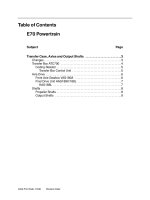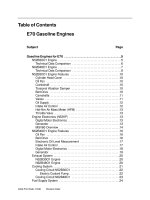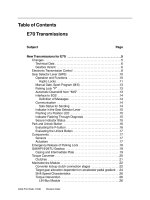C920 02
Bạn đang xem bản rút gọn của tài liệu. Xem và tải ngay bản đầy đủ của tài liệu tại đây (32.22 KB, 3 trang )
Designation: C 920 – 02
Standard Specification for
Elastomeric Joint Sealants1
This standard is issued under the fixed designation C 920; the number immediately following the designation indicates the year of
original adoption or, in the case of revision, the year of last revision. A number in parentheses indicates the year of last reapproval. A
superscript epsilon (e) indicates an editorial change since the last revision or reapproval.
This standard has been approved for use by agencies of the Department of Defense.
C 1193 Guide for Use of Joint Sealants2
C 1246 Test Method for Effects of Heat Aging on Weight
Loss, Cracking and Chalking of Elastomeric Sealants After
Cure2
C 1247 Test Method for Durability of Sealants Exposed to
Constant Immersion in Liquids2
1. Scope
1.1 This specification covers the properties of a cured
single- or multicomponent cold-applied elastomeric joint sealant for sealing, caulking, or glazing operations on buildings,
plazas, and decks for vehicular or pedestrian use, and types of
construction other than highway and airfield pavements and
bridges.
1.2 A sealant meeting the requirements of this specification
shall be designated by the manufacturer to be one or more of
the types, classes, grades, and uses defined in Section 7.
1.3 The values stated in SI units are to be regarded as the
standard. The values given in parentheses are for information
only.
1.4 This standard is similar, but not identical, to ISO 11600.
3. Terminology
3.1 Definitions—Refer to Terminology C 717 for definitions
of the following terms used in this specification: adhesive
failure, caulking, chemically curing sealant, cohesive failure,
cure, cured, elastomeric, glazing, joint, primer, seal, sealant.
4. Classification of Sealants
4.1 A sealant qualifying under this specification shall be
classified as to type, grade, class, and use as follows:
4.1.1 Type S—A single-component sealant.
4.1.2 Type M—A multicomponent sealant.
4.1.3 Grade P—A pourable or selfleveling sealant that has
sufficient flow to form a smooth, level surface when applied in
a horizontal joint at 4.4°C (40°F).
4.1.4 Grade NS—A nonsag or gunnable sealant that permits
application in joints on vertical surfaces without sagging or
slumping when applied at temperatures between 4.4 and 50°C
(40 and 122°F).
4.1.5 Class 100/50—A sealant that when tested for adhesion
and cohesion under cyclic movement (8.8) shall withstand an
increase of at least 100 % and a decrease of at least 50 % of the
joint width as measured at the time of application, and, in
addition, meet all the requirements of this specification.
4.1.6 Class 50—A sealant that when tested for adhesion and
cohesion under cyclic movement (8.8) shall withstand an
increase and decrease of at least 50 % of the joint width as
measured at the time of application, and, in addition, meet all
the requirements of this specification.
4.1.7 Class 35—A sealant that when tested for adhesion and
cohesion under cyclic movement (8.8) shall withstand an
increase and decrease of at least 35 % of the joint width as
measured at the time of application, and, in addition, meet all
the requirements of this specification.
2. Referenced Documents
2.1 ASTM Standards:
C 510 Test Method for Staining and Color Change of
Single- or Multicomponent Joint Sealants2
C 639 Test Method for Rheological (Flow) Properties of
Elastomeric Sealants2
C 661 Test Method for Indentation Hardness of
Elastomeric-Type Sealants by Means of a Durometer2
C 679 Test Method for Tack-Free Time of Elastomeric
Sealants2
C 717 Terminology of Building Seals and Sealants2
C 719 Test Method for Adhesion and Cohesion of Elastomeric Joint Sealants Under Cyclic Movement (Hockman
Cycle)2
C 793 Test Method for Effects of Accelerated Weathering
on Elastomeric Joint Sealants2
C 794 Test Method for Adhesion-in-Peel of Elastomeric
Joint Sealants2
C 1183 Test Method for Extrusion Rate of Elastomeric
Sealants2
1
This specification is under the jurisdiction of ASTM Committee C24 on
Building Seals and Sealants and is the direct responsibility of Subcommittee C24.10
on Specifications, Guides and Practices.
Current edition approved Jan. 10, 2002. Published March 2002. Originally
published as C 920 – 79. Last previous edition C 920 – 01.
2
Annual Book of ASTM Standards, Vol 04.07.
Copyright © ASTM International, 100 Barr Harbor Drive, PO Box C700, West Conshohocken, PA 19428-2959, United States.
1
C 920 – 02
6.3 The sealant shall be intended for use only on clean, dry
surfaces. Where a primer is recommended by a manufacturer
for a specific surface, all tests on that surface shall include the
primer.
4.1.8 Class 25—A sealant that when tested for adhesion and
cohesion under cyclic movement (8.8) shall withstand an
increase and decrease of at least 25 % of the joint width as
measured at the time of application, and, in addition, meet all
the requirements of this specification.
4.1.9 Class 121⁄2 —A sealant that when tested for adhesion
and cohesion under cyclic movement (8.8) shall withstand an
increase and decrease of at least 121⁄2 % of the joint width as
measured at the time of application, and, in addition, meet all
the requirements of this specification.
4.1.10 Use T—A sealant designed for use in joints in
pedestrian and vehicular traffic areas such as walkways, plazas,
decks and parking garages.
4.1.11 Use NT—A sealant designed for use in joints in
nontraffic areas.
4.1.12 Use I—A sealant designed for use in joints which are
submerged continuously in a liquid.
4.1.13 Use M—A sealant that meets the requirements of this
specification when tested on mortar specimens in accordance
with 9.9 and 9.10.
4.1.14 Use G—A sealant that meets the requirements of this
specification when tested on glass specimens in accordance
with 9.9-9.11.
4.1.15 Use A—A sealant that meets this specification when
tested on aluminum specimens in accordance with 9.9 and
9.10.
4.1.16 Use O—A sealant that meets this specification when
tested on substrates other than the standard substrates in
accordance with 9.9 and 9.10.
NOTE 1—The proper use of primers (or surface conditioners) in
connection with the application of sealants is described in detail in Guide
C 1193. This guide also describes proper methods for joint design,
back-up materials, surface preparation, tooling of sealant, and other
important procedures in sealant application in buildings.
6.4 The same conditions of time, temperature, and humidity
shall be used for cure of test specimens for Test Methods
C 661, C 719, C 794, and C 1247.
7. Significance and Use
7.1 This specification covers several classifications of sealants as described in Section 4 for various applications. It
should be recognized by the purchaser or design professional
that not all sealants meeting this specification are suitable for
all applications and all substrates. It is essential, therefore, that
the applicable type, grade, class, and use be specified so that
the proper classification of sealant is provided for the intended
use. Test methods relate to special standard specimen substrates of mortar, glass, and aluminum. If tests are required
using substrates in addition to or other than the standard, they
should be so specified for testing.
8. Physical Requirements
8.1 Rheological Properties:
8.1.1 Grade P (pourable or selfleveling) sealant shall have
flow characteristics such that when tested in accordance with
Test Method C 639 it shall exhibit a smooth, level surface.
(Refer to Types I and III in the test.)
8.1.2 Grade NS (nonsag) or gunnable sealant shall have
flow characteristics such that when tested in accordance with
Test Method C 639 it does not sag more than 4.8 mm (3⁄16 in.)
in vertical displacement. Also the sealant shall show no
deformation in horizontal displacement. (Refer to Types II and
IV in the test.)
8.2 Extrusion Rate:
8.2.1 Type S (single component), Grade P (pourable or
selfleveling) sealant shall have an extrusion rate of not less than
10mL/min when tested in accordance with Test Method
C 1183.
8.2.2 Type S (single component), Grade NS (nonsag or
gunnable sealant) shall have an extrusion rate of not less than
10 mL/min when tested in accordance with Test Method
C 1183.
8.3 Application Life:
8.3.1 Type M (multicomponent), Grade P (pourable or
selfleveling) sealant, when tested in accordance with Test
Method C 1183 shall be extrudable at a rate of not less than 10
mL/min 3 h after mixing.
8.4 Hardness:
8.4.1 Use T (traffic) sealant shall have a hardness reading,
after being properly cured, of not less than 25 or more than 50
when tested in accordance with Test Method C 661.
5. Materials and Manufacture
5.1 A single-component sealant shall be a uniform mixture
of a consistency suitable for immediate application by hand or
pressure caulking gun or by hand tool. The sealant when
completely cured shall form an elastomeric solid capable of
maintaining a seal.
5.2 A multicomponent chemically curing sealant shall be
furnished in two or more components. The resulting mixture
shall be uniform and of a consistency suitable for immediate
application by hand or pressure caulking gun, or by hand tool.
The sealant when completely cured shall form an elastomeric
solid capable of maintaining a seal.
6. General Requirements
6.1 Stability:
6.1.1 A single-component sealant, when stored in the original unopened container at temperatures of not more than 27°C
(80°F) shall be capable of meeting the requirements of this
specification for at least 6 months after date of delivery.
6.1.2 A multicomponent sealant, when stored in the original
unopened container at temperatures of not more than 27°C
(80°F) shall be capable of meeting the requirements of this
specification for at least 6 months after date of delivery.
6.2 Color—The color of the sealant, after curing 14 days in
a laboratory controlled at 23 6 2°C (73.4 6 3.6°F) and 50 6
5 % relative humidity, shall be that color which has been
agreed upon between the purchaser and the supplier.
NOTE 2—In applications of proper design, some sealants with less than
25 hardness may be used in traffic-bearing areas if recommended for use
2
C 920 – 02
8.12 Effects of Continuous Immersion for Use I Sealants:
8.12.1 Class 1—After 6 weeks exposure, the total loss in
bond and cohesion areas among the specimens tested for each
substrate shall be no greater than 9.5 cm2(1.5 in.2) when tested
according to Test Method C 1247 with standard glass, aluminum, or any other substrate specified.
8.12.2 Class 2—After 10 weeks exposure, the total loss in
bond and cohesion areas among the specimens tested for each
substrate shall be no greater than 9.5 cm2(1.5 in.2) when tested
according to Test Method C 1247 with standard glass, aluminum, or any other substrate specified.
by the manufacturer and accepted by the purchaser.
8.4.2 Use NT (nontraffic) sealant shall have a hardness
reading, after being properly cured, of not less than 15 or more
than 50 when tested in accordance with Test Method C 661.
8.5 Effects of Heat Aging—The sealant shall not lose more
than 7 % of its original weight or show any cracking or
chalking when tested in accordance with Test Method C 1246.
8.6 Tack-Free Time—There shall be no transfer of the
sealant to the polyethylene film when tested at 72 h in
accordance with Test Method C 679.
8.7 Stain and Color Change—The sealant shall not cause
any visible stain on the top surface of a white cement mortar
base when tested in accordance with Test Method C 510.
8.8 Adhesion and Cohesion Under Cyclic Movement—The
total loss in bond and cohesion areas among the three specimens tested for each surface shall be no more than 9 cm2(11⁄2
in.2) when tested in accordance with Test Method C 719 with
standard mortar, glass, and aluminum or any other specified
substrates.
8.9 Adhesion-in-Peel—The peel strength for each individual test shall not be less than 22.2 N (5 lbf) when tested in
accordance with Test Method C 794 with standard mortar,
glass, and aluminum or any other specified substrate. In
addition, the sealant shall show no more than 25 % adhesive
bond loss for each individual test.
9. Test Methods
9.1 Standard Conditions for Laboratory Tests—All tests
described in the following paragraphs shall be performed in a
laboratory controlled at 23 6 2°C (73.4 6 3.6°F) and 50 6
5 % relative humidity. The sealant sample shall be conditioned
at this temperature and relative humidity for at least 24 h before
laboratory tests are made.
9.2 Rheological Properties—Test Method C 639.
9.3 Extrusion Rate—Test Method C 1183.
9.4 Application Life—Test Method C 1183.
9.5 Hardness—Test Method C 661.
9.6 Effects of Heat Aging—Test Method C 1246
9.7 Tack-Free Time—Test Method C 679.
9.8 Stain and Color Change—Test Method C 510.
9.9 Adhesion and Cohesion After Cyclic Movement—Test
Method C 719.
9.10 Adhesion-in-Peel—Test Method C 794.
9.11 Adhesion-in-Peel After Ultraviolet Exposure Through
Glass—Test Method C 794.
9.12 Effects of Accelerated Weathering— Test Method
C 793.
9.13 Sealants Exposed to Continuous Immersion—Test
Method C 1247.
NOTE 3—Curing conditions are specified by all of the test methods
cited. The manufacturer may request other conditions than those specified
for the curing period provided they meet the following requirements: ( 1)
the curing period shall extend for 21 days; ( 2) the temperature during the
curing period shall not exceed 50°C (122°F); and (3) the amended curing
conditions recommended by the manufacturer shall also be applied to the
durability, adhesion in peel, and ultraviolet radiation exposure tests.
8.10 Adhesion-in-Peel for Use G Exposed to Ultraviolet
Exposure Through Glass—The peel strength for each individual test shall not have less than 22.2 N (5 lbf) and the
compound shall be no more than 25 % adhesive bond loss for
each individual test when tested in accordance with Test
Method C 794.
8.11 Effects of Accelerated Weathering— The sealant shall
show no cracks greater than those shown in Example #2 of Fig.
1 in Test Method C 793 after the specified ultraviolet exposure
and shall show no cracks greater than those shown in Example
#2 of Fig. 2 in Test Method C 793 after exposure at cold
temperature and the bend test when tested in accordance with
Test Method C 793.
10. Packaging and Marking
10.1 Packaged materials that are certified by the manufacturer to be in compliance with this specification shall be labeled
as to type, class, grade, and use, in accordance with Section 7.
10.2 All certification to this specification shall state time,
temperature, and humidity of cure used in the tests.
11. Keywords
11.1 continuous immersion; elastomeric sealants; joint sealants; sealants; specification
ASTM International takes no position respecting the validity of any patent rights asserted in connection with any item mentioned
in this standard. Users of this standard are expressly advised that determination of the validity of any such patent rights, and the risk
of infringement of such rights, are entirely their own responsibility.
This standard is subject to revision at any time by the responsible technical committee and must be reviewed every five years and
if not revised, either reapproved or withdrawn. Your comments are invited either for revision of this standard or for additional standards
and should be addressed to ASTM International Headquarters. Your comments will receive careful consideration at a meeting of the
responsible technical committee, which you may attend. If you feel that your comments have not received a fair hearing you should
make your views known to the ASTM Committee on Standards, at the address shown below.
This standard is copyrighted by ASTM International, 100 Barr Harbor Drive, PO Box C700, West Conshohocken, PA 19428-2959,
United States. Individual reprints (single or multiple copies) of this standard may be obtained by contacting ASTM at the above
address or at 610-832-9585 (phone), 610-832-9555 (fax), or (e-mail); or through the ASTM website
(www.astm.org).
3









